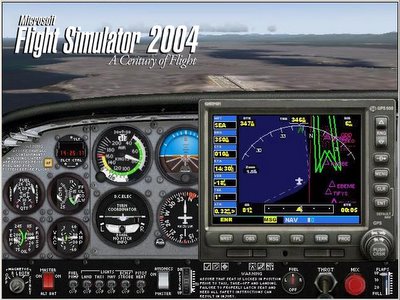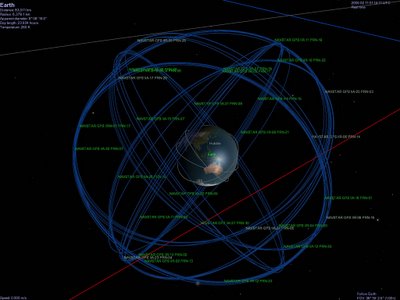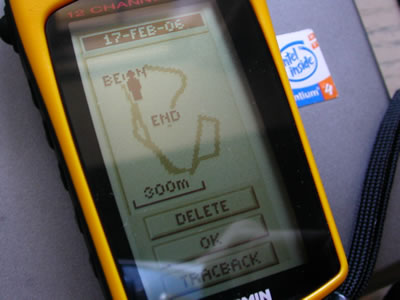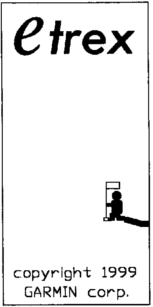Last week, I was in Perth, and I found six! I think I'm getting better, there seems to be this 'feel the Force' thing that more experienced Geocachers possess. LOL Geocaching is essentially a treasure hunt. One person hides a tupperware that contains goodies and a log book somewhere (adhering to 'leave no trace' and other guidelines), then posts the coordinates on the website so that others can find it. Visitors sign a logbook and leave comments if they are able to find the cache. They may also want to take stuff from the tupperware, but they need to put something back in, sort of like an 'exchange'. Alternatively, it's quite all right to 'take nothing, leave nothing'. As the tagline at geocaching.com says, 'The game where you are the search engine'. It's like being a member of a Star Trek Away Team; you're given some coordinates, now bring your Tricorder, go to that location any way you want, and do some investigation! In our case, we don't have a Tricorder. Most people use a GPS. Although it's possible to do this without a GPS, it becomes almost impossible unless there are lots of hints and pictures that's provided by other people who've found the cache.
Other things that I use are Google Earth with the geocaching.com addon, a compass with a base plate, and CacheMate for downloading all the coordinates into my Palmpilot. Now, the fun thing about this is that folks who hide caches often choose very interesting places that a reasonable person would probably never have a chance to visit if not to participate in the search. For example, the first cache I found in Singapore was a picnic ground next to an expressway! It's really a nice place to stroll to...

 Here's a screenshot of the geocaches currently in Singapore. There're more than 100, which will probably take me some time to go through them.
Here's a screenshot of the geocaches currently in Singapore. There're more than 100, which will probably take me some time to go through them.
 I had a bit more luck in Perth last week when I found six caches. Another fun thing that's found in some places were 'travel bugs'. TBs are 'released' by their owners all over the world, and they 'hitch hike' across the oceans to be deposited in new cache locations, and the cycle repeats itself. I've obtained two travel bugs, and one originated from the States a couple of years ago. Hopefully it can go on to the rest of Asia...
King's Park was a special place to do some Geocaching. The Aussies are quite elaborate, making interesting name cards put into the tupperware (or in this case a big ammo box!) so that the owner knows who has dropped by. This particular Travel Bug Passport Centre is a place where interstate and international visitors can come and pick up hitch-hiking TBs.
I had a bit more luck in Perth last week when I found six caches. Another fun thing that's found in some places were 'travel bugs'. TBs are 'released' by their owners all over the world, and they 'hitch hike' across the oceans to be deposited in new cache locations, and the cycle repeats itself. I've obtained two travel bugs, and one originated from the States a couple of years ago. Hopefully it can go on to the rest of Asia...
King's Park was a special place to do some Geocaching. The Aussies are quite elaborate, making interesting name cards put into the tupperware (or in this case a big ammo box!) so that the owner knows who has dropped by. This particular Travel Bug Passport Centre is a place where interstate and international visitors can come and pick up hitch-hiking TBs.

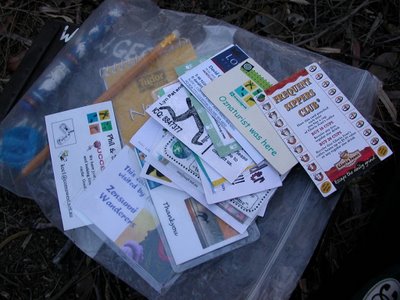 Anyway, geocaching is a very 'explorer-type ' activity, and a good excuse for me to take the train to that station that I've never been before, or to walk to that rock next to the Tower in the middle of the 10 km trail between Bukit Timah and MacRitchie Reservoir just to write some notes in a logbook LOL.
Anyway, geocaching is a very 'explorer-type ' activity, and a good excuse for me to take the train to that station that I've never been before, or to walk to that rock next to the Tower in the middle of the 10 km trail between Bukit Timah and MacRitchie Reservoir just to write some notes in a logbook LOL.
